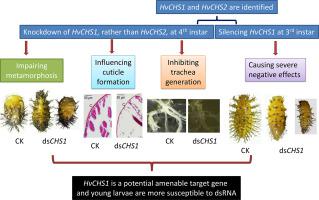Pesticide Biochemistry and Physiology ( IF 4.2 ) Pub Date : 2021-07-17 , DOI: 10.1016/j.pestbp.2021.104934 Lin-Hong Jiang 1 , Li-Li Mu 1 , Lin Jin 1 , Ahmad Ali Anjum 1 , Guo-Qing Li 1

|
Chitin synthase (CHS) plays a critical role in chitin synthesis and excretion. In most insects, CHSs have been segregated into 1 and 2 classes. CHS1 is responsible for chitin production in the ectodermally-derived epidermal cells. CHS2 is dedicated to chitin biosynthesis in the midgut peritrophic matrix (PM). Henosepilachna vigintioctopunctata is a serious pest of Solanaceae and Cucurbitaceae plants. In this study, we identified HvCHS1 and HvCHS2. We found that HvCHS1 was abundantly transcribed in the larval tracheae and epidermis, whereas HvCHS2 was mainly expressed in the guts. Escherichia coli HT115 expressed double stranded RNAs targeting HvCHS1 and HvCHS2 (dsCHS1 and dsCHS2) were used to immerse potato foliage and the treated leaves were provided to the newly-molted fourth- and third-instar larvae. Ingestion of dsCHS1 by the fourth-instar larvae significantly diminished the target mRNA level and had slight influence on the expression of HvCHS2. In contrast, consumption of dsCHS2 significantly lowered the target mRNA level but triggered the transcription of HvCHS1. Knockdown of HvCHS1, rather than HvCHS2, arrested larval development and impaired larva-pupa-adult transition. A large proportion of HvCHS1 hypomorphs became stunting prepupae, deformed pupae or misshapen adults. Moreover, knockdown of HvCHS1 damaged gut integrity, decreased cuticle thickness, and delayed the formation of newly-generated cuticle layer during ecdysis. Furthermore, depletion of HvCHS1 inhibited the development of trachea system and thinned tracheal taenidia. Ingestion of dsCHS1 at the third-instar stage caused similar but severe negative effects. Our results demonstrated that HvCHS1 is responsible for chitin biosynthesis during ecdysis. Moreover, HvCHS1 is a potential amenable target gene and young larvae are more susceptible to dsRNA.
中文翻译:

甲壳素合成酶 1 而不是 2 的 RNAi 导致 Henosepilachna vigintioctopunctata 的生长延迟和蜕皮缺陷
几丁质合成酶 (CHS) 在几丁质合成和排泄中起关键作用。在大多数昆虫中,CHS 被分为 1 类和 2 类。CHS1 负责在外胚层来源的表皮细胞中产生几丁质。CHS2 致力于中肠周围营养基质 (PM) 中的几丁质生物合成。Henosepilachna vigintioctopunctata是茄科和葫芦科植物的严重害虫。在这项研究中,我们确定了HvCHS1和HvCHS2。我们发现HvCHS1在幼虫气管和表皮中大量转录,而HvCHS2主要在肠道中表达。大肠杆菌HT115 表达靶向HvCHS1和HvCHS2(ds CHS1和ds CHS2)用于浸渍马铃薯叶子,并将处理过的叶子提供给新蜕皮的四龄和三龄幼虫。四龄幼虫摄入 ds CHS1显着降低了目标 mRNA 水平,对HvCHS2的表达有轻微影响。相比之下,ds CHS2 的消耗显着降低了目标 mRNA 水平,但触发了HvCHS1的转录。击倒HvCHS1,而不是HvCHS2,逮捕幼虫发育和受损的幼虫-蛹-成虫过渡。很大比例的HvCHS1次胚变成发育不良的预蛹、变形的蛹或畸形的成虫。此外,敲除 HvCHS1 会破坏肠道完整性,减少角质层厚度,并延迟蜕皮过程中新生角质层的形成。此外,HvCHS1 的消耗抑制了气管系统的发育,并使气管绦虫变薄。在三龄期摄入 ds CHS1 会导致类似但严重的负面影响。我们的结果表明Hv CHS1 负责蜕皮期间的几丁质生物合成。此外,HvCHS1是一个潜在的目标基因,年轻的幼虫更容易受到 dsRNA 的影响。











































 京公网安备 11010802027423号
京公网安备 11010802027423号